Studying a horse (part 4)
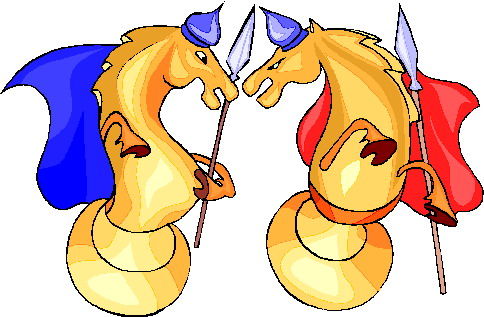
We continue to study chess pieces with the child. Now comes the turn of the horse.
Due to the end of the school year, there was some delay and a gap between the queen and the horse. Considering the fact that the knight is the most difficult piece in chess to study, the material was prepared a little longer than usual. But he came out. All diagrams with explanations under the cut - you are welcome.
The last article about the queen turned out not the most successful, so it took some rethinking and work on the bugs. In this material, the structure of the material feed will be somewhat different. The material is divided into several thematic parts, after tasks under the spoilers, solutions will be given. Below the spoiler will be comments to the tasks.
Let me remind you, this series of articles is written at the rate of I.G. Sukhin. All the following positions in the diagrams are developed by I.G. Sukhin and given them in the textbook: Sukhin I.G. Chess, first year, or There cells are black and white wonders and secrets full: A textbook for primary school, the first year of study. In 2 parts. - Obninsk: Spiritual Revival, 2017. And I set out my vision, how they can be used in the classroom, what typical difficulties children can have, and how they can be overcome. The article provides only a portion of the provisions of the specified textbook - in the textbook they are much more. To the textbook developed and methodological guide: Sukhin I.G. Chess, first year, or Learning and learning. - Obninsk: Spiritual Revival, 2015. It spelled out in detail how each chess lesson of the course should be conducted.
Previous Cycle Articles:
A Dozen Tips - How to Teach a Child Chess. And not only (introduction).
We study the rook (part 1).
We study the elephant (part 2).
We study the queen (part 3).
Story
In ancient chess, this figure depicted a "cavalry" - a horseman on a horse. In the process of translating the names of the figures the horseman disappeared from his horse! But not everywhere - in many European countries they continue to call the horse a rider. In France, a chess knight is a cavalier (cavalier), in England a knight (knight). In part, this is due to the fact that in these countries, in the Middle Ages, there were knights, and how much they loved to play chess ... Where could there be without a knight on the board?
But in other languages the “human component” of this figure has disappeared. We call it simply “horse.” And for example, in Germany (springer), Poland (skoczek), Croatia (skakač), its name translates as “jumper”, “horse”.
And also, in ancient times, there were such horses that flew! They were called "Pegasi". Our horse is a distant descendant of Pegasus, he also knows how to fly, but not far ...
Knight's move
The knight's move in chess is one of the most difficult to learn. At the same time, almost all children know that he walks "the letter G". Oh, how I love to argue with them and say that he walks with the letter L ... Oh, not so - with the letter L. The first brain explosion occurs at this stage.
Why am I doing this - when children associate the knight's move with a letter that is simple for themselves, they also try to tell themselves that this is a simple figure. No matter how wrong! If you pass a horse with such an approach, then you will not tame it. I saw how many guys (and not only guys - and quite mature husbands at the board) that they do not feel the horse and do not understand the horse. Yes - they know the course in which the horse walks, but this alone is not enough.
With the study of the horse begins the first lesson on the horse. But first, I attract the attention of children and try to prevent them from getting tired at the beginning of the lesson. If the child does not understand how the horse walks, then it will be difficult for them to play and fight against the horse.
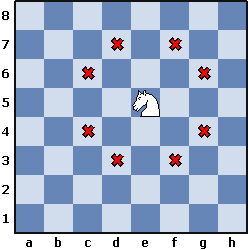
Particular emphasis is placed on the fact that the horse is the only figure that jumps over other figures, be it your own or your opponent's.
Actually these explanations for the beginning of attempts is enough. Next, the tasks begin, and that's where the children have difficulty. Therefore, the first lesson on the horse is one of the most difficult in the course of studying figures.
I personally explain the knight's move to children like this - “the knight goes straight to two squares, and then it makes a single dismount to the side”. So (our letter D):
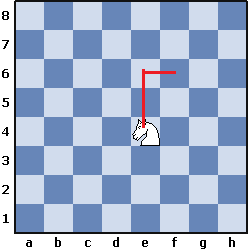
But, as it turned out with time, it is more convenient for some children to make a knight's move differently! You yourself are surprised (by the way, not the worst option). “A horse goes diagonally one cage, and then makes a straight dash of one cage.” Here it is:
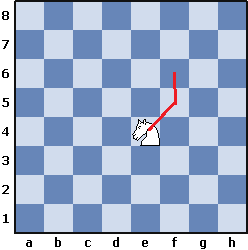
No need to break children under your perception. If it is more convenient for him, then let him remember so. Those who go further in chess, one way or another, will then simply see where the knight goes.
Before you start the task with the child, I remind you - the child must arrange all the tasks on the chessboard and then decide. Solving a task on a computer screen is counterproductive for the development of a child’s brain. Consider this when you give your fumes to solve puzzles. And now, actually to them the most - to the tasks.
Tame a Horse (Stage 1)
No man is an island
Those who have read previous articles know this type of assignments. Our goal is to beat all the opponent's checkers, destroying one checker each turn. As a result, the right decision is a decision with the number of moves equal to the number of checkers. The move is a checker.
I remind you that checkers are not a chess piece, and they don’t walk or beat us.
Exercise 1

Decision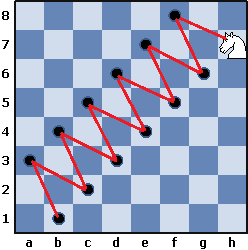

It would seem - what is so complicated. Jump and jump ... but no! Some children stand up straight and can not understand how to jump a horse. And here that comes to the aid spiders!
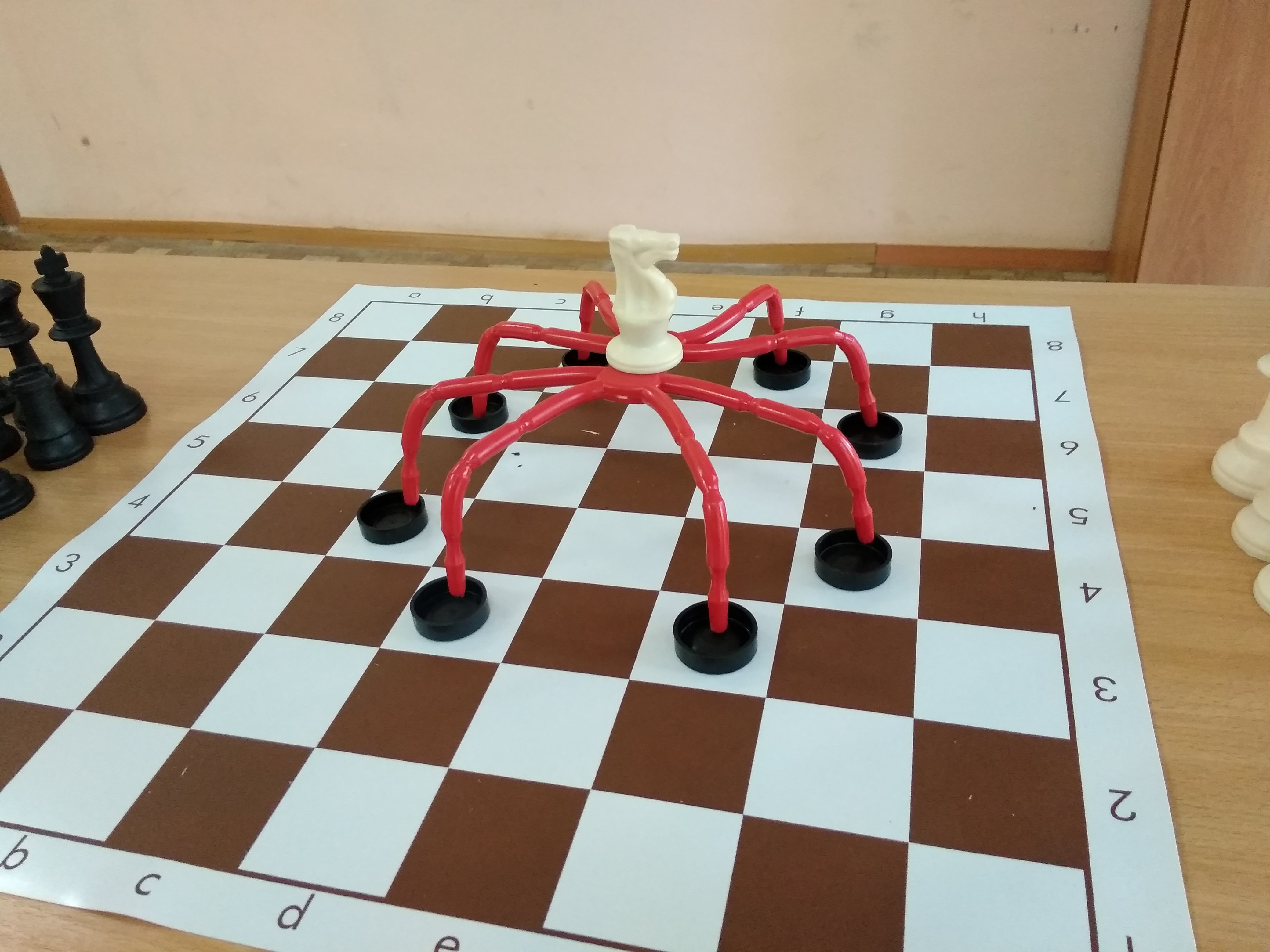

If someone did not recognize him - this is the usual holder for the tablet. It has exactly 8 legs - according to the number of moves of the horse. For a board of 35 centimeters (this is a small board) - suitable for a 7-inch tablet, for 43 centimeters boards - a 10-inch spider. You can buy it in any computer store (well, or at worst - I buy in Auchan).
Believe me - the children are delighted with him, but ....! I usually take it away as soon as I see that the child has understood how the horse is walking. From personal experience, I can say that most of the children can do without it, but (do not forget) - our goal is to teach ALL children to play chess. And the easier they will be given some tasks - the greater the chance that the child will love chess. We do not raise champions - but we develop children.
The duration of the help of the spider - according to the child’s understanding of the knight's move. Some need one task, some - all 3. It is individual. But the most important thing is not to miss the moment when the child began to see the horse. Let him still difficult, but the spider must be taken. Honestly - I rarely had more than 3 tasks with a spider, more often 2 tasks were enough.
Let us return to our task - most often the children, when solving it, by the middle understand how to move further with the knight. They even can not figure out a horse, and immediately put a piece on the field where it will go. Let it go! Their task is to get used to the horse. Even if they have not yet learned the move. Any brisk horse must first merge with the owner. And this task, in this regard, fits perfectly. If you notice - there are no jumps through the figures! Our goal is to show the trajectory of the horse.
Task 2
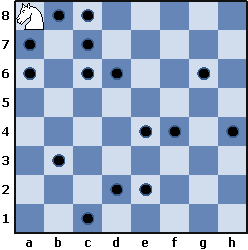
Decision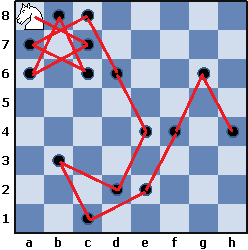

This task is a little more difficult than the previous one. Because here the horse begins to jump over the checkers. The fact is that many children when moving to the previous figures move the piece on the board. Although I initially expose the requirement that the figure was raised over the board. But alas - they do not. But then the horse comes into action, and ... And then the horse must be raised, it cannot be moved along the board - the figures fall.
The most difficult thing is to get loose on the first platform. Help comes often. Next, the child begins to see the horse moves himself.
Task 3
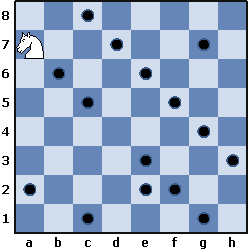
Decision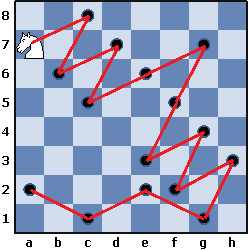

After the previous task - this task for the rest. There are no jumps over checkers, linear (almost) move. After the two previous tasks - this serves to consolidate the material covered.
In fact, you can come up with your own tasks for the horse, the main thing is that the decision is the only one that is correct. And there is no second solution. For those who are far from pedagogy - I will explain. The whole course of study of any new material is based on the tasks of the "closed" type. These are tasks that have the only correct solution. This is the principle of pedagogy. The child should receive knowledge and skills to solve problems. Yes - there are no such tasks in life, but we are preparing for life. And then we apply this knowledge. And in life, we solve problems of the “open” type - they have a lot of correct solutions.
Shortest way
These tasks are designed to teach the child to find the fastest way to get the figure "from point A to point B". In tasks of this type, the goal is to learn how to use the features of the figure that we are studying. In tasks of this type, you need to announce in advance the number of moves for which the destination field will be reached (it is marked with a cross).
Task 1
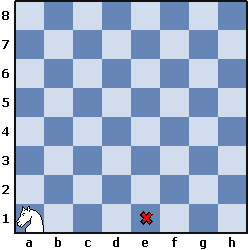
Go to the field marked with a cross in 2 moves.
Decision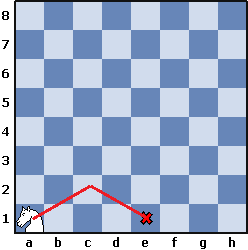

The easiest task. The main thing in this task is to make sure that the child correctly finds the solution. There is nothing difficult here, just a task for seed and interest.
Task 2
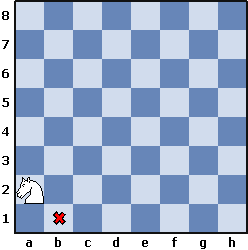
Go to the field marked with a cross in 2 moves.
Decision

This task seems easy only at first glance. A lot of children stumble on it. The difficulty is that you need to jump a horse from the goal, and then go back. But the solution to this problem gives an understanding that the horse is not as simple as it seems. But trust me - this is only the beginning ... It will be even more difficult next (naturally for children).
Task 3
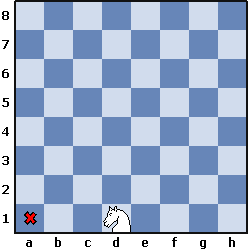
Go to the field marked with a cross in 3 moves.
Decision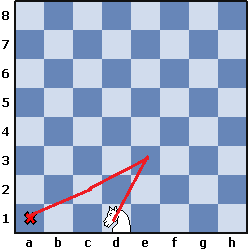

Few of the children of 6-8 years old decide it immediately. Usually they sit for about 5 minutes, sometimes 10, sometimes 30 ... The difficulty is that you have to jump to the other side of the goal. And then come back. When children solve this problem - it is necessary to carefully monitor that the child did not leave the decision and tried to find a solution. Sometimes it is necessary to push the child to the correct version, sometimes to prompt, sometimes to make the first move. Let me remind you once again - we need to ensure that the child’s desire to play chess has not disappeared. Unsolved problems discourage chess, so you need to help, but in moderation. The child should understand that the tasks are not as simple as they seem, but they are completely in his teeth.
Well, I singled out these two types of tasks separately, after passing them - the child should be able to walk with a horse. This stage is a taming. And now the training of the horse.
Horse training (stage 2)
Labyrinth
These tasks are the most difficult of the entire course of initial training. There are cases when I give them to children who already know how to play, and they are also difficult to solve. And for beginners who are just learning chess, these are the most difficult tasks.
Let me remind you that the labyrinth built on a chessboard of white checkers must be passed to the end - to the field with a cross. On the field marked with a cross, I usually put a black checker (after all, we play white, and black is our enemy). It is impossible to beat white checkers (these are the walls of the labyrinth). Naturally, when solving tasks with a horse, you can jump over walls.
All the tasks I give below will have their own names. I invented them in the course of training when I asked the children. They like me too.
And one more tip - do not try to solve tasks for the child. He will guess himself - believe me. But sometimes it is necessary to suggest - without this, nowhere. Sometimes help with hints. But, in no case do not throw the child alone with the labyrinth - he must feel support, even when he walks through such a dangerous labyrinth.
Task 1. The challenge for obstinacy
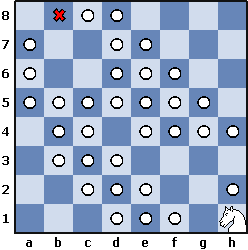
Decision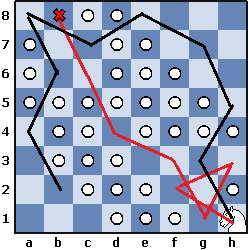

In the decision, the decision itself, I showed in red. And black shows the way children usually walk. ALL children go this way. For all the time that I teach chess, few have gone (2-3 people). Most often they were lucky - they made the first move correctly and then immediately solved the problem. If the first move is made incorrectly - then the straight road to a dead end.
Now why I call the task "the problem of obstinacy." It is because of this black path. I don’t know what bothers children, but when they get close to a desired goal (a red cross), they are happy, but when they start walking further, they stand in a stupor. They begin to roll back moves, look at other options ... But in my memory, the first move was guessed by 2 or 3 children. All the rest continued to abut and abut against the wrong decision.
Most often, I help them so that they do not get stuck completely. But I try to do it not earlier than 10-15 minutes after the start of the task.
Task 2. Horse can dance
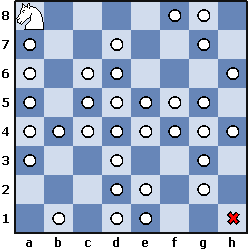
Funny? And yet. See it.
Decision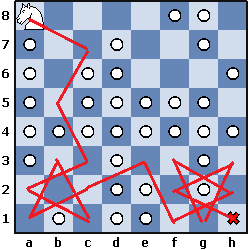

In this task, the false (dead-end) path is not so long. Children quickly dismiss him. But they are waiting for another trouble - you must be able to dance a horse. Quite often they throw a caracoling knight on a patch, either confusing in the fields, or simply deciding that the right way is not there.
You should carefully monitor the child so that he does not abandon his horse much, and tell him that it is good to continue to look for moves further.
Task 3. Hippodrome
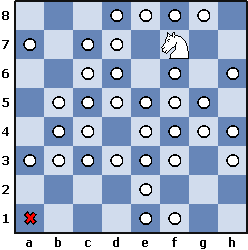
Where, if not on the racetrack, roll a horse? Here he rolls around the board.
Decision

After solved previous problems - this is solved easier. The main problem is that when we come close to the field with a cross - we need to continue to move on. And make almost two full circles.
For the rest, this labyrinth is not the most difficult compared to the previous ones.
Outwit sentries.
Further development of the maze - outwit sentries. In this type of mission, we need to get to the field marked with a cross, but so that on the way to it we do not get hit by enemy figures. Since we have a stage for beginners, these are only horses. And yes - black pieces do not walk - only our horse.
I also want to note one feature of this type of tasks. The fact is that in these tasks everything is made up specifically so that in addition to the correct knight, there are no other moves! Those. From each field, a knight can make only two moves — to the field from where he came from, and to the field that is next in the path of movement. Those. the task for the child is, in fact, that he sees the one and only right field for the move (and remembers where he just came from). All other fields are either under the blows of black horses, or there are white checkers (obstacles).
Exercise 1
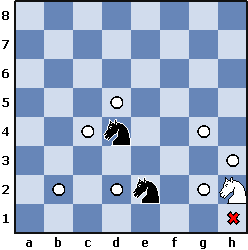
Decision

The main difficulty in solving this problem is not to be afraid of the black horse on the neighboring cage. This is the most difficult thing that children have to overcome. Well and still - to learn to see those fields where enemy horses beat.
Task 2

Decision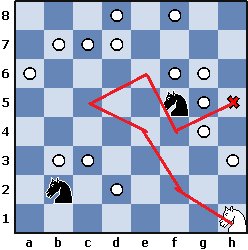

Again, we are learning to look for the only right move, and we go over the fear of the black horse on the neighboring cage.
Task 3
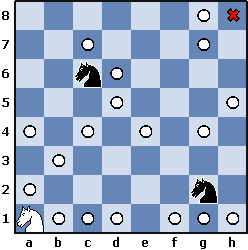
Decision

Race Stage (Stage 3)
I called this stage exactly this way - because here we start fights with the enemy's horses. And as a result of his passing, the child must develop a clear understanding of the weaknesses of the horse.
Control field capture
In these tasks, we also need to get on the field marked with a cross. But the main difficulty is that the black horse begins to walk. And at the same time, this is a plus in our direction. The main objective of the tasks is to convey to the child what is necessary to think not only about his own figures, but to calculate the moves of the opponent. Those who have completed past assignments know this. Let me remind you - before you make your move you need to think - and where will the opponent go?
Exercise 1
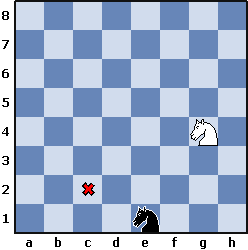
Decision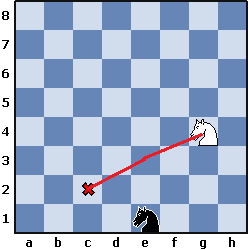

In this task, everything is very simple - now the black horse protects the marked cell, but in the next move he will stop protecting it. We only need to attack her, and the black horse will go away himself.
Task 2
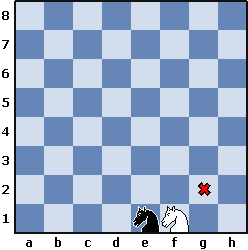
Decision

The task is similar to the first. No comments.
Task 3

Decision

This task is interesting because the solution to how to get to the marked field was sought in task number 3 “The shortest path”. And yet the children do not remember this. It is more complicated here than in the previous two tasks - it is necessary to calculate how the black horse will defend the field - the correct report - with each odd move. Those. we need to attack the h1 field with an even move so that the black horse in turn leaves and stops defending him.
In fact, this task is not as easy for children as you might think. Explanations to the child - will help a little. Just make the child move the pieces. Both white and black. As it was written in earlier articles - the more the pieces move along the board - the faster they start moving in the head. Without this, nowhere. And just explanations - children will not understand what you want from them.
Mobility restriction
In this task, your goal is to limit the opponent's figure, so that later you can kill her. At the same time, the black horse walks. The main meaning of these tasks is that the child must learn (albeit not immediately) to move the opponent's pieces. And try to predict his moves.
Along the way, it is necessary to explain - a horse figure, though jumping, but very inactive. With some desire to catch a horse is not such a difficult task.
Exercise 1
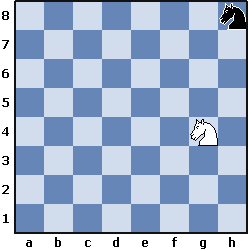
Decision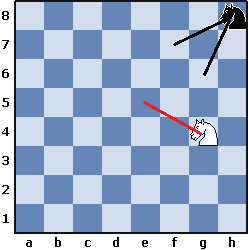

A horse in the corner of the board is probably the weakest piece in chess. And it's easy to catch, and there is absolutely no reason to be afraid of him there. But for children, trying to catch a horse in the corner is a difficult task at first. In the decision, I specifically showed a move where the black horse could go, and this should be shown to the child too.
In general, the knight in the corner is weak (only 2 moves), the knight on the edge of the board is weak (not 2, but only 3-4 moves). The power of a horse is in the middle of the board, but by no means on the edge.
Task 2
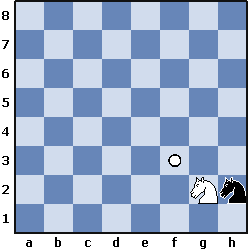
Decision

Horse on the edge of the board. As already stated above, he is weak here. Easy to catch. The black lines indicate the possible moves of the black knight, and these two fields must be closed.
Children usually solve this problem on their own, but it is more complicated than the first. And therefore, they spend a little more time on it.
Task 3. Hunting the Mustang
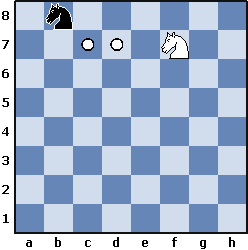
Decision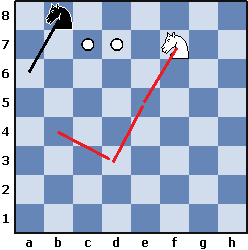

In this task, at first glance, there is no solution ... All children think so. But the black horse is caught! To do this, try to drive the horse to the edge of the board, and not let him out.
The main solution method is to see where the black horse will go. And try to get him back. In no case do not let the horse to the center. As soon as he jumps out into the open - you will not catch him.
The task of all the proposed - quite complicated. Actually, I usually practice dropping children to the ground after the euphoria about the ease of tasks after the previous ones on it. Oh again about the benefits of the pieces on the board ... A child will not solve this problem in his mind. It is difficult for an adult, but what about children?
Well, we studied the weak points of the horse. This is the limitation on the edge of the board, inactivity. The clearer the children understand these features of the horse - the easier it will be for them to play in the future. And meaningfully.
Learning to attack (stage 4)
We've figured out the knight's weaknesses. And now we need to learn how to attack them, and understand his strengths. Let's start.
Attack the figure
In these tasks, the solutions are very, very simple. You just need to attack the black figure, so that this figure does not kill you. But in the case of the horse, this task is simplified by the fact that the horse walks as no figure moves. So, the one we attack will not be able to attack you. Remember - the task to make one move and only attack. Do not beat the figure.
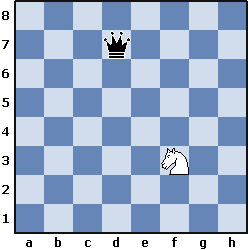
Decision

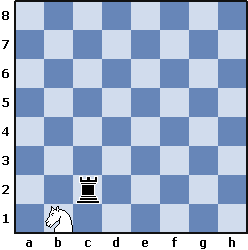
Decision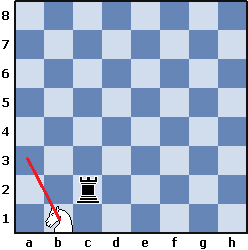

Attack two figures
This task - a banal horse knight. But in order to apply it - you need to learn it. So we teach the children of the fork - to attack two figures. Again - you just need to attack, but do not beat the figure. Children often want to beat the black figure, but they must be stopped. After all, black will then make his move.
Exercise 1.

Decision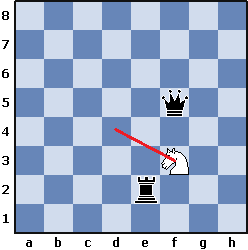

Task 2.
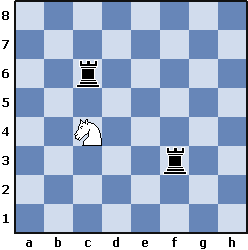
Decision

Task 3.
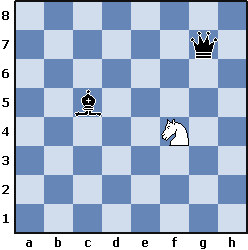
Decision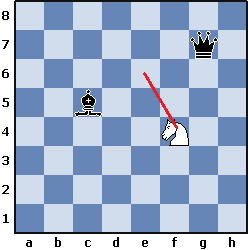

Beat unprotected figure
In this task, you must already kill the figure that is without protection. Here we practice two skills - the ability to see who is attacked by our horse, and who are protected by black pieces.
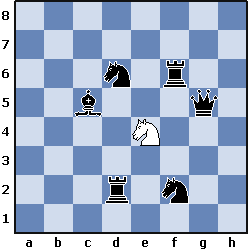
Decision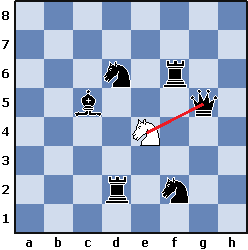

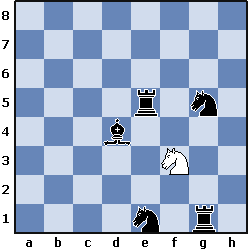
Decision

To battle! (stage 5)
Well, we are ready to go into battle with the enemy figures. Now it all starts in earnest.
Outwit the sentries
The meaning of tasks in the same - you need to get to the field marked with a cross. On the way, do not stand on the field with white checkers, and do not fall under the blow of black pieces. Black pieces do not walk.
Seems easy? Well, try it.
Exercise 1
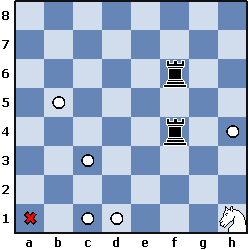
Decision

About the nuance of solving such problems was written above - the knight usually has one move to move forward. This task is a small exception - there is a dead end development. For example g3-e2-dead end. Children may face these options when deciding and should cut them off and move on. And so - the task is not the most difficult.
Task 2

Decision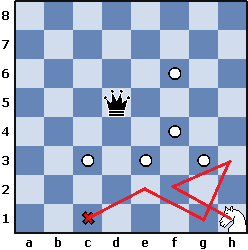

For some reason, children rarely solve this problem right away. Here the dead-end solution pulls the children to him - f2-g4-h6-dead end. Children do not like to give up this decision, and continue to hammer it over and over again. Although you just need to make another second move.
Task 3
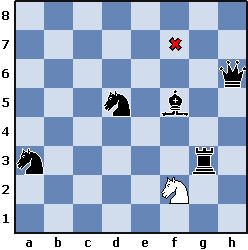
Decision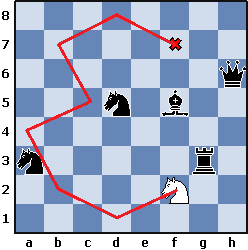

When this task is placed on a blackboard, the eyes of an abundance of figures in children run up. But the solution is very simple - the knight has only one move at a time. And it must be done. All other moves are blocked by black pieces. But the problem is solved difficult and long.
Take off the watch
Tasks similar to the previous ones, but there is no control field, but there are enemy figures. They must be beaten. It is impossible to become white checkers, black pieces do not walk.
Task 1
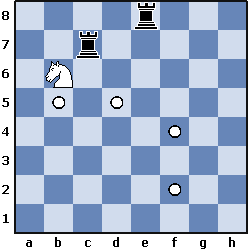
Decision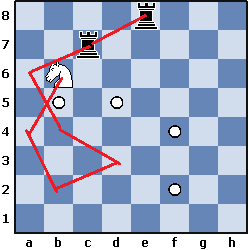

Again - from each position of the knight there is only one move. The rest are blocked (or a dead end on the d1 field). Check for yourself. But children most often do not see this unique move ...
Task 2
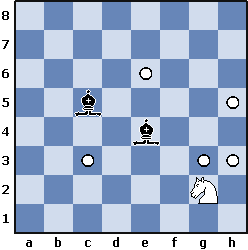
Decision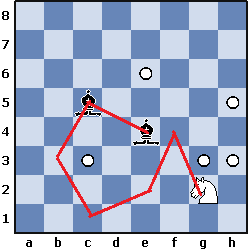

More interesting task. The fact is that at first glance a knight has many moves, but all of them turn out to be a dead end for testing. And the right way under the spoiler.
Task 3
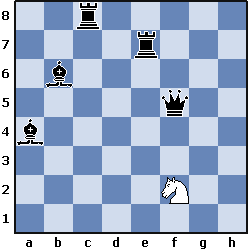
Decision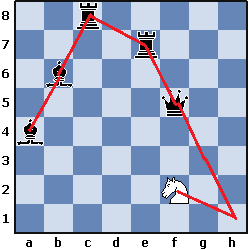

And here everything is similar. Well, except that a lot of figures. But the move is the only one everywhere.
Control field capture
And again capture the control field. Only now with other figures, and not just with horses.
Exercise 1
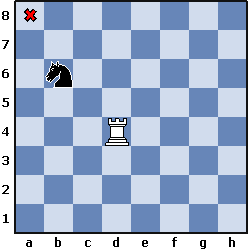
Decision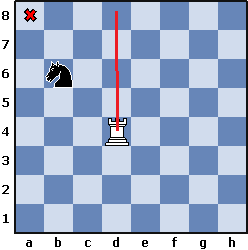

Task 2
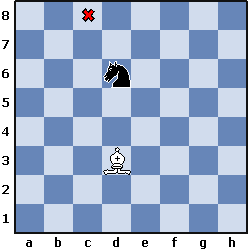
Decision

Task 3

Decision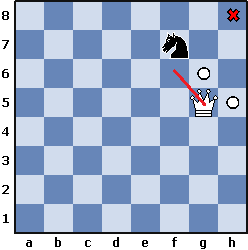

In all tasks, the inertia of the horse must be used. This feature of his passed earlier, so here we fix this knowledge once again.
Mobility restriction
Again, the restriction of mobility, but on all previously completed figures. As they say - no comment.
Task 1
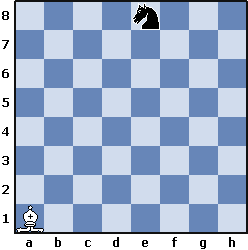
Decision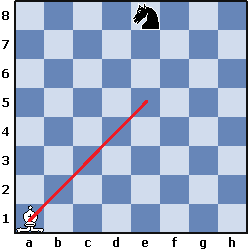

Task 2
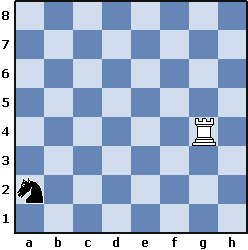
Decision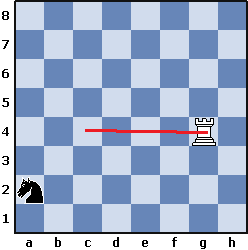

Task 3
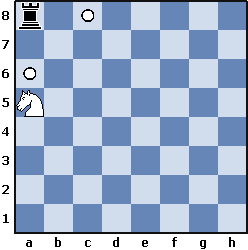
Decision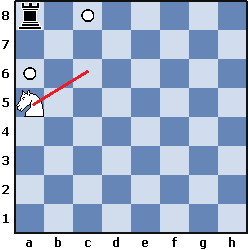

Final exam (stage 6)
The game of destruction
The meaning of tasks is simple - it is necessary to determine who will win: white or black. White's first move. Figures take turns. The only catch is the size of the board. This is 3x3, 4x4, 2x3 and so on. And if it seems to you that these tasks are all simple - listen to me. When I'm on a horse, I give these tasks in the classroom howl (Uuuuuu, again ...). Although during the passage of these tasks on the boat, they are happy with them. At the beginning.
Exercise 1
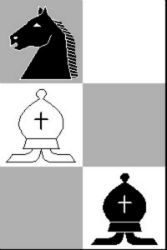
Decision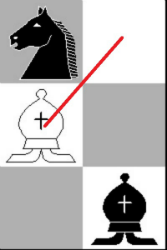

Task 2

Decision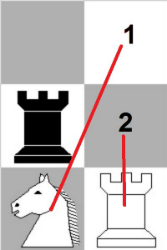
Порядок ходов помечен цифрами.

Порядок ходов помечен цифрами.
Task 3
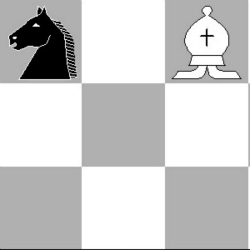
Decision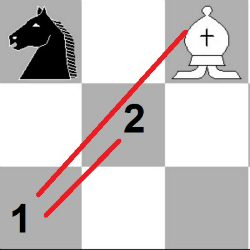
Порядок ходов помечен цифрами.

Порядок ходов помечен цифрами.
Task 4
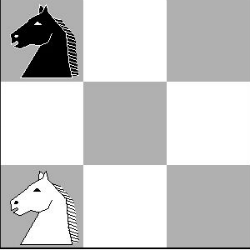
Decision

Conclusion
That's all. Horse passed. Not the easiest task, especially labyrinths. But as my experience shows, the knight doesn’t cause any difficulties later on in almost all children who complete these tasks. I compare on other children who are engaged in comparable time. We intersect in tournaments and I happen to play with other people's children and see what they have and how.
Naturally, if the child is engaged in the result, no doubt. He will spin a horse like a true chess player. But again, our task is to develop children. Who wants - let him then go to chess, who does not want - let him do other things. Dancing, for example. I have a lot of girls, and the goal of making them chess players is not worth it. The task of the school and additional education is the comprehensive development of the child. And chess here is a serious help.
I will make another digression - those children who did not go through the previous figures - then they cope very badly with the horse. Rook, elephant, queen - they serve as a preparation for a complex horse. When a child goes to a horse, he should not think about how other figures go - he should know them. If he is distracted by an elephant or a queen, it will be more difficult for him to understand the knight. And, quite possibly, will lead to the rejection of chess themselves in the future.
I want to draw attention (for the umpteenth time) - the goal of this course in child development. In no case in preparing him for the championship. I have repeatedly prepared children for school studying the moves of chess pieces. The systematic and consistent conduct of classes sometimes gives the child more than cramming materials in other subjects. At the same time, children perceive chess as a game, and this facilitates communication with them. The age of 6 years is the most to prepare for school and to start studying chess. The main thing is not to discourage interest in learning and in chess.
If you notice - in the initial course there is almost no game on the full board. And this is justified - a complete set of figures for a child of 6-7 years old is often too complicated to understand. The fact that a child at this age does not know how to calculate his or her opponent’s moves is a fact. Therefore, all sports sections at this age is a mockery of children in the first place. As a parent, no one forbids you to mock a child, but pay first of all to his psychological stability. Not all children can and can lose. Can you imagine how stressful it is for a child? And if you also require a result?
I use chess as a tool for development. But not in any way as a goal. Yes - if a child comes across who wants and can become a master, this is good. But there is a problem - to grow such a master is very, very difficult. It takes years of time and a sea of work. And - the work of a coach with experience. Trying to educate the master at home, on my own - I am sure you will fail. Entrust this moment to professionals if you really want to grow a discharger. But do not take it yourself.
If you want good for your child, then develop it with the help of chess. Course I.G. Sukhina "There are black-and-white miracles and secrets full of cells there" is ideal for this.
PS I am sometimes in the comments asked about classes with younger children (4-5 years). I can say that I.G. Sukhin is the book "Chess for the smallest." There age just from 3-4 years. It is available for a child of this age. Teach walking figures on this book can be. It has been reprinted annually since 2000, the last reprint was in 2018.
